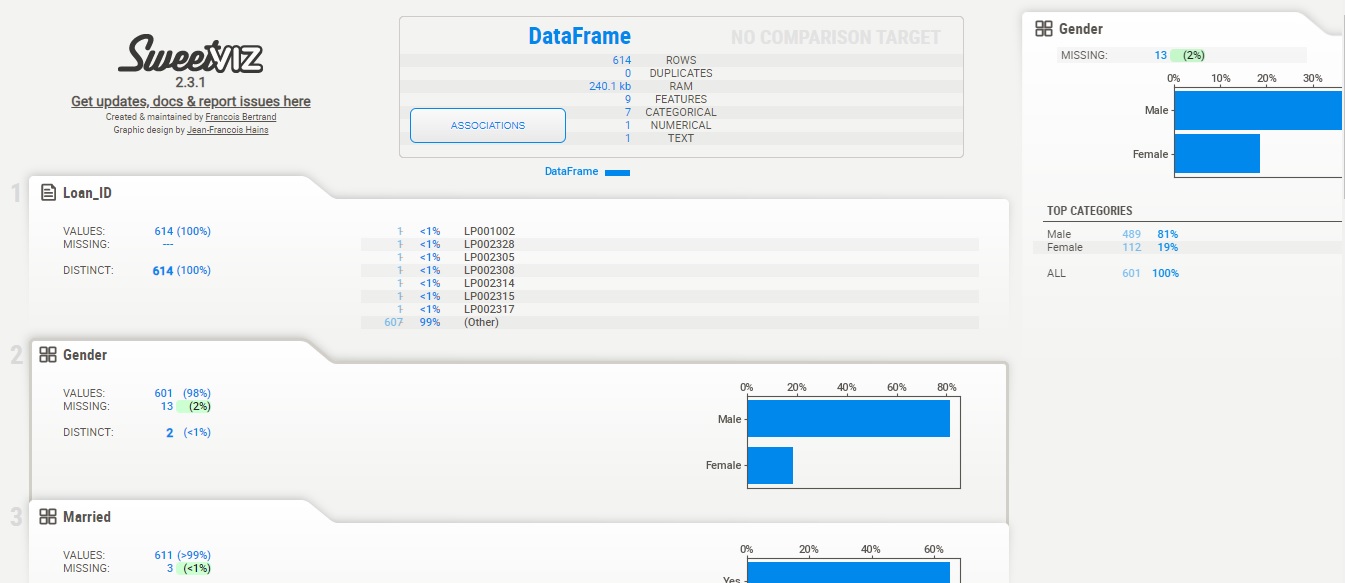Exploratory Data Analysis (EDA)
Exploratory Data Analysis (EDA) is an approach to analyzing data sets to summarize their main characteristics, often with visual methods.
EDA typically involves generating summary statistics for numerical data and visualizing data distributions through histograms, box plots, scatter plots, etc.
It helps analysts and data scientists understand what the data can tell us beyond the formal modeling or hypothesis-testing tasks.
Univariate Analysis
- Univariate analysis explores each variable in a data set, separately.
- It looks at the range of values, as well as the central tendency of the values.
- It describes the pattern of response to the variable.
- It is quantitative data exploration we do at the beginning of any analysis.
- The purpose is to make data easier to interpret and to understand how data is distributed within a sample or population being studied.
Also helps us narrow down exactly what types of bivariate and multivariate analyses we should carry out.
Univariate analysis:
- Summary statistics -Determines the value’s center and spread. Like mean, median, standard deviation, etc.
- Frequency table -This shows how frequently various values occur.
- Charts -A visual representation of the distribution of values.
Visualizations, such as histograms, distributions, frequency tables, bar charts, pie charts, and boxplots, are also commonly used in univariate analysis.
Bivariate Analysis:
- Bivariate analysis is slightly more analytical than Univariate analysis.
- When the data set contains two variables and researchers aim to undertake comparisons between the two data set then Bivariate analysis is the right type of analysis technique.
- This step is performed when inputs and output are known.
- 1st variable will be Inputs
- 2nd variable will be output/target variable.
Bivariate Analysis:
Categorical v/s Numerical – sns.barplot(x=data[‘department_name’], y=data[‘length_of_service’])
Numerical v/s Numerical – sns.scatterplot(x=data[‘length_of_service’],y=data[‘age’])
Categorical v/s Categorical – sns.countplot(data[‘STATUS_YEAR’],hue=data[‘STATUS’])
Multivariate Analysis
- Plot a pair plot with Hue
- sns.heatmap(data.corr(), annot=True)
Python Implementation for EDA:
- Importing libraries
import pandas as pd
import numpy as np
import seaborn as sns
import matplotlib.pyplot as plt
%matplotlib inline
- Load Dataset
data = pd.read_csv('/content/drive/MyDrive/Data Science/CDS-07-Machine Learning & Deep Learning/06. Machine Learning Model /07_Support Vector Machines/SVM Class /Test_loan_approved.csv')
- See first five rows
data.head()
Output:
Loan_ID Gender Married Education Self_Employed LoanAmount Loan_Amount_Term Credit_History Loan_Status (Approved)
0 LP001002 Male No Graduate No NaN 360.0 1.0 Y
1 LP001003 Male Yes Graduate No 128.0 360.0 1.0 N
2 LP001005 Male Yes Graduate Yes 66.0 360.0 1.0 Y
3 LP001006 Male Yes Not Graduate No 120.0 360.0 1.0 Y
4 LP001008 Male No Graduate No 141.0 360.0 1.0 YSee last five rows
data.tail()
Output:
Loan_ID Gender Married Education Self_Employed LoanAmount Loan_Amount_Term Credit_History Loan_Status (Approved)
609 LP002978 Female No Graduate No 71.0 360.0 1.0 Y
610 LP002979 Male Yes Graduate No 40.0 180.0 1.0 Y
611 LP002983 Male Yes Graduate No 253.0 360.0 1.0 Y
612 LP002984 Male Yes Graduate No 187.0 360.0 1.0 Y
613 LP002990 Female No Graduate Yes 133.0 360.0 0.0 N- See if data has any null values
data.info()
<class 'pandas.core.frame.DataFrame'> RangeIndex: 614 entries, 0 to 613 Data columns (total 9 columns): # Column Non-Null Count Dtype --- ------ -------------- ----- 0 Loan_ID 614 non-null object 1 Gender 601 non-null object 2 Married 611 non-null object 3 Education 614 non-null object 4 Self_Employed 582 non-null object 5 LoanAmount 592 non-null float64 6 Loan_Amount_Term 600 non-null float64 7 Credit_History 564 non-null float64 8 Loan_Status (Approved) 614 non-null object dtypes: float64(3), object(6) memory usage: 43.3+ KB
Insights:
Data contain object, integer & float data
- There is no null Value
- See summary Statistics for numerical variables
data.describe()
Output:
LoanAmount Loan_Amount_Term Credit_History
count 592.000000 600.00000 564.000000
mean 146.412162 342.00000 0.842199
std 85.587325 65.12041 0.364878
min 9.000000 12.00000 0.000000
25% 100.000000 360.00000 1.000000
50% 128.000000 360.00000 1.000000
75% 168.000000 360.00000 1.000000
max 700.000000 480.00000 1.000000Note: If you find that the standard deviation of a variable is zero, The variable may not be useful for analysis or modeling,
- See summary Statistics for Categorical variables
data.describe(include="O")
Output:
Loan_ID Gender Married Education Self_Employed Loan_Status (Approved)
count 614 601 611 614 582 614
unique 614 2 2 2 2 2
top LP001002 Male Yes Graduate No Y
freq 1 489 398 480 500 422
Insights:
- Male loan approved most
- Married people loan approved most
- Count the number of unique values in each column
data.nunique()
Loan_ID 614 Gender 2 Married 2 Education 2 Self_Employed 2 LoanAmount 203 Loan_Amount_Term 10 Credit_History 2 Loan_Status (Approved) 2
- Checking for missing values (null values)
data.isnull().sum()
Loan_ID 0 Gender 13 Married 3 Education 0 Self_Employed 32 LoanAmount 22 Loan_Amount_Term 14 Credit_History 50 Loan_Status (Approved) 0
- Counting the occurrences of each unique value in a Series or a specific column of a DataFrame for categorical feature
data['Married'].value_counts()
Output: Yes 398 No 213 Name: Married, dtype: int64
- Use Python package to get EDA report
- Univariate analysis–sweetviz
# install sweetviz
!pip install sweetviz
Output: Collecting sweetviz Downloading sweetviz-2.3.1-py3-none-any.whl.metadata (24 kB) Requirement already satisfied: pandas!=1.0.0,!=1.0.1,!=1.0.2,>=0.25.3 in /usr/local/lib/python3.10/dist-packages (from sweetviz) (2.1.4) Requirement already satisfied: numpy>=1.16.0 in /usr/local/lib/python3.10/dist-packages (from sweetviz) (1.26.4) Requirement already satisfied: matplotlib>=3.1.3 in /usr/local/lib/python3.10/dist-packages (from sweetviz) (3.7.1) Requirement already satisfied: tqdm>=4.43.0 in /usr/local/lib/python3.10/dist-packages (from sweetviz) (4.66.5) Requirement already satisfied: scipy>=1.3.2 in /usr/local/lib/python3.10/dist-packages (from sweetviz) (1.13.1) Requirement already satisfied: jinja2>=2.11.1 in /usr/local/lib/python3.10/dist-packages (from sweetviz) (3.1.4) Requirement already satisfied: importlib-resources>=1.2.0 in /usr/local/lib/python3.10/dist-packages (from sweetviz) (6.4.3) Requirement already satisfied: MarkupSafe>=2.0 in /usr/local/lib/python3.10/dist-packages (from jinja2>=2.11.1->sweetviz) (2.1.5) Requirement already satisfied: contourpy>=1.0.1 in /usr/local/lib/python3.10/dist-packages (from matplotlib>=3.1.3->sweetviz) (1.2.1) Requirement already satisfied: cycler>=0.10 in /usr/local/lib/python3.10/dist-packages (from matplotlib>=3.1.3->sweetviz) (0.12.1) Requirement already satisfied: fonttools>=4.22.0 in /usr/local/lib/python3.10/dist-packages (from matplotlib>=3.1.3->sweetviz) (4.53.1) Requirement already satisfied: kiwisolver>=1.0.1 in /usr/local/lib/python3.10/dist-packages (from matplotlib>=3.1.3->sweetviz) (1.4.5) Requirement already satisfied: packaging>=20.0 in /usr/local/lib/python3.10/dist-packages (from matplotlib>=3.1.3->sweetviz) (24.1) Requirement already satisfied: pillow>=6.2.0 in /usr/local/lib/python3.10/dist-packages (from matplotlib>=3.1.3->sweetviz) (9.4.0) Requirement already satisfied: pyparsing>=2.3.1 in /usr/local/lib/python3.10/dist-packages (from matplotlib>=3.1.3->sweetviz) (3.1.2) Requirement already satisfied: python-dateutil>=2.7 in /usr/local/lib/python3.10/dist-packages (from matplotlib>=3.1.3->sweetviz) (2.8.2) Requirement already satisfied: pytz>=2020.1 in /usr/local/lib/python3.10/dist-packages (from pandas!=1.0.0,!=1.0.1,!=1.0.2,>=0.25.3->sweetviz) (2024.1) Requirement already satisfied: tzdata>=2022.1 in /usr/local/lib/python3.10/dist-packages (from pandas!=1.0.0,!=1.0.1,!=1.0.2,>=0.25.3->sweetviz) (2024.1) Requirement already satisfied: six>=1.5 in /usr/local/lib/python3.10/dist-packages (from python-dateutil>=2.7->matplotlib>=3.1.3->sweetviz) (1.16.0) Downloading sweetviz-2.3.1-py3-none-any.whl (15.1 MB) ━━━━━━━━━━━━━━━━━━━━━━━━━━━━━━━━━━━━━━━━ 15.1/15.1 MB 51.2 MB/s eta 0:00:00 Installing collected packages: sweetviz Successfully installed sweetviz-2.3.1
import sweetviz as sv # library for univariant analysis
my_report1 = sv.analyze(data)## pass the original dataframe
my_report1.show_html() # Default arguments will generate to "SWEETVIZ_REPORT.html"
Output: Done! Use 'show' commands to display/save. [100%] 00:00 -> (00:00 left) Report SWEETVIZ_REPORT.html was generated! NOTEBOOK/COLAB USERS: the web browser MAY not pop up, regardless, the report IS saved in your notebook/colab files.

- Bivaraite analysis–Autoviz
# install autoviz
!pip install autoviz
Output: Collecting autoviz Downloading autoviz-0.1.905-py3-none-any.whl.metadata (14 kB) Requirement already satisfied: xlrd in /usr/local/lib/python3.10/dist-packages (from autoviz) (2.0.1) Requirement already satisfied: wordcloud in /usr/local/lib/python3.10/dist-packages (from autoviz) (1.9.3) Collecting emoji (from autoviz) Downloading emoji-2.12.1-py3-none-any.whl.metadata (5.4 kB) Collecting pyamg (from autoviz) Downloading pyamg-5.2.1-cp310-cp310-manylinux_2_17_x86.........
from autoviz import AutoViz_Class
AV = AutoViz_Class()
bivariate_report = AV.AutoViz('/content/drive/MyDrive/Data Science/CDS-07-Machine Learning & Deep Learning/06. Machine Learning Model /07_Support Vector Machines/SVM Class /Test_loan_approved.csv',verbose=1)
Output:
Imported v0.1.905. Please call AutoViz in this sequence:
AV = AutoViz_Class()
%matplotlib inline
dfte = AV.AutoViz(filename, sep=',', depVar='', dfte=None, header=0, verbose=1, lowess=False,
chart_format='svg',max_rows_analyzed=150000,max_cols_analyzed=30, save_plot_dir=None)
Shape of your Data Set loaded: (614, 9)
#######################################################################################
######################## C L A S S I F Y I N G V A R I A B L E S ####################
#######################################################################################
Classifying variables in data set...
Number of Numeric Columns = 2
Number of Integer-Categorical Columns = 0
Number of String-Categorical Columns = 0
Number of Factor-Categorical Columns = 0
Number of String-Boolean Columns = 5
Number of Numeric-Boolean Columns = 1
Number of Discrete String Columns = 0
Number of NLP String Columns = 0
Number of Date Time Columns = 0
Number of ID Columns = 1
Number of Columns to Delete = 0
9 Predictors classified...
1 variable(s) removed since they were ID or low-information variables
List of variables removed: ['Loan_ID']
To fix these data quality issues in the dataset, import FixDQ from autoviz...
All variables classified into correct types.
Number of All Scatter Plots = 3
All Plots done
Time to run AutoViz = 2 seconds
###################### AUTO VISUALIZATION Completed ########################

Manual Plotting:
#For Numerical data
import matplotlib.pyplot as plt
import seaborn as sns
plt.figure(figsize=(8,7), facecolor='white')#To set canvas
plotnumber = 1#counter
dataN = data[['LoanAmount',"Loan_Amount_Term","Credit_History"]] # create new dataframe with numerical column
for column in dataN.columns:#accessing the columns
if plotnumber<=4 :
ax = plt.subplot(2,2,plotnumber)
sns.histplot(x=dataN[column],hue=data['Loan_Status (Approved)'])
plt.xlabel(column,fontsize=10)#assign name to x-axis and set font-20
plt.ylabel('Loan Status',fontsize=10)
plt.title('Loan status')
plotnumber+=1#counter increment
plt.tight_layout()
plt.show()
# For Categorical data
dataC = data[['Gender',"Married","Education","Self_Employed"]] # create new dataframe with numerical column
plt.figure(figsize=(7,8), facecolor='white')#To set canvas
plotnumber = 1#counter
for column in dataC:#accessing the columns
ax = plt.subplot(3,3,plotnumber)
sns.countplot(x=dataC[column],hue=data['Loan_Status (Approved)'])
plt.xlabel(column,fontsize=10)#assign name to x-axis and set font-20
plt.ylabel('Loan Status',fontsize=10)
plotnumber+=1#counter increment
plt.tight_layout()
Multivariate Analysis
sns.pairplot(data.drop('Loan_ID',axis=1))

